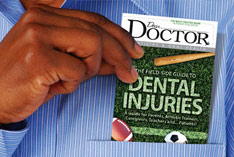An Introduction to Sports Injuries & Dentistry
Treatment, prevention and other issues affecting athletes' performance and well-being
(Continued)
 |
| Download a FREE copy of Dear Doctor's Field-Side Pocket Guide for managing dental injuries |
What To Do When Injuries Occur — A Field-Side Guide
It is unrealistic to assume that certified athletic trainers, school nurses, and especially parents know what to do for a dental or sports related injury. While your dentist is always the first line of defense, dental injuries can have improved outcomes if the public is aware of first-aid measures. There are some simple rules to follow and it is helpful to think in terms of three categories of need when dental injuries occur: Immediate — within minutes, Urgent — within 6 hours and Less Urgent — within 12 hours. Using this as a basis we have included a “Field-Side Guide” for management of dental injuries for non-professionals, members of the public at large.
Traumatic Injuries to the Teeth
What about more involved injuries? It's quite shocking when injury occurs and teeth are “luxated” – dislodged, “avulsed” – knocked out or severely fractured exposing the pulp (nerve). We have also included a section on the treatment of specific injuries to teeth. This area includes root canal or endodontic treatment of injuries affecting the central pulp chamber of teeth, which contains vital living tissue (including the nerve). A review is provided to show how appropriate and timely treatment can provide comfort, healing and restoration of damaged teeth. Importantly, this includes the circumstances of the injury, the age of the injured party and stage of development of the injured tooth or teeth — all of which help determine the long-term outlook and planning for the future.
An Ounce of Protection
When it comes to sports-related dental injuries, it's all about prevention — and that revolves largely around protective equipment. To prevent dental injuries, there are two essential pieces of equipment — headgear and mouthguards, both of which help distribute the forces of impact, thereby reducing the risk of severe injury. Mouthguards are by far the best equipment for protecting both the teeth and mouth in contact sports — when they are used. For many sports, like football, it's an obvious need.
As a rule of thumb, mouthguards should be used when the sport involves a ball, stick, puck, or physical contact with another player. And, they should be used not only during games or events, but also during practice.
All mouthguards are not alike. Each offer a different level of protection. The preferred type is the custom-fit mouthguard. This requires a visit to a dentist who makes precise models of the teeth upon which the guard is made, either by the dentist or a dental laboratory. Not only does this produce the best fit and highest level of protection for the athlete, but custom-fit mouthguards also accommodate other comfort features, including a more natural airflow for easier breathing.
The market has recently seen the introduction of so-called high performance mouthpieces or performance enhancing mouth wear. While research supporting their prowess is ongoing and their price is high, evidence to support their effectiveness is scant.

